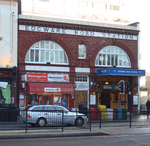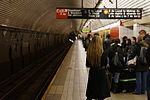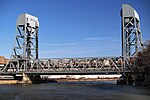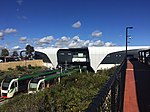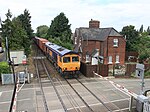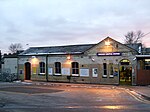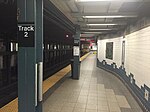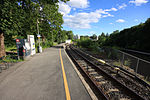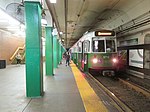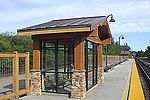Portal:Trains/Selected article/2022 archive
This is an archive of article summaries that have appeared in the Selected article section of Portal:Trains in 2022. For past archives, see the complete archive page.
- Week 1
Edgware Road is a London Underground station on the Bakerloo line, located in the City of Westminster. It is between Paddington and Marylebone stations on the line and falls within Travelcard zone 1. The station is located on the north-east corner of the junction of Edgware Road, Harrow Road and Marylebone Road. It is adjacent to the Marylebone flyover. A separate station of the same name, opened by the Metropolitan Railway in 1863 as part of the world's first underground railway, now served by the Circle, District and Hammersmith & City lines is nearby, to the south of Marylebone Road.
Recently selected: - Eastern Østfold Line - East West MRT line
- Week 2
Eidanger Station (Norwegian: Eidanger stasjon) is a disused railway station at Eidanger in Porsgrunn, Norway. Located at the intersection of the Bratsberg Line, Brevik Line and Vestfold Line, it is located 192.60 kilometers (119.68 mi) from Oslo. The station buildings were designed by Balthazar Lange. The station opened as part of the Vestfold Line on 23 November 1882, with the Brevik Line opening in 1895. From 1916 the Brevik- and Bratsberg Lines received standard gauge, and Eidanger was used for transshipment with the narrow-gauge Vestfold Line. The station's importance diminished with the latter's gauge conversion in 1941. The commuter train service between Brevik and Skien terminated in 1964, reducing most of the station's traffic. It was closed on 2 March 1987, but remains in use as a passing loop.
Recently selected: Edgware Road tube station (Bakerloo line) - - Eastern Østfold Line
- Week 3
The EMD SD70 is a series of diesel-electric locomotives produced by the US company Electro-Motive Diesel in response to the GE Dash 9-44CW. Production commenced in late 1992 and since then over 5,700 units have been produced; most of these are the SD70M and SD70MAC models. While the majority of the production was ordered for use in North America, various models of the series have been used worldwide. All locomotives of this series are hood units with C-C trucks, except the SD70ACe-P4 (and presumably the SD70MACH as well) which has a B1-1B wheel configuration, and the SD70ACe-BB, which has a B-B-B-B wheel arrangement. Superseding the HT-C truck, a new bolsterless radial HTCR truck was fitted to all EMD SD70s built 1992–2002; in 2003 the non-radial HTSC truck (basically the HTCR made less costly by removing radial components) was made standard on the SD70ACe and SD70M-2 models; the radial HTCR truck remained available as an option. All SD70ACe and SD70M-2 locomotives are, from the factory, equipped with one Nathan Airchime K5LLA-R1L airhorn mounted on a high-profile base. Due to height clearance restrictions, production models of the SD70ACe-T4 will be equipped with one K5LLA airhorn, mounted on a low-profile base, facing forward, and one "dual tone" K-13B airhorn, mounted over the rear headlight, facing rearward.
Recently selected: Eidanger Station - Edgware Road tube station (Bakerloo line) -
- Week 4
The Carolwood Pacific Railroad (CPRR) was a 7+1⁄4-inch (184 mm) gauge ridable miniature railroad run by Walt Disney in the backyard of his home in the Holmby Hills neighborhood of Los Angeles, California. It featured the Lilly Belle, a 1:8-scale live steam locomotive named after Disney's wife, Lillian Disney, and built by the Walt Disney Studios' machine shop. The locomotive made its first test run on December 24, 1949. It pulled a set of freight cars, as well as a caboose that was almost entirely built by Disney himself. It was Disney's lifelong fascination with trains, as well as his interest in miniature models, that led to the creation of the CPRR. The railroad, which became operational in 1950, was 2,615 feet (797 m) long and encircled his house. The backyard railroad attracted visitors to Disney's home; he invited them to ride and occasionally drive his miniature train. In 1953, after an accident occurred in which a guest was injured, the CPRR was closed to the public. The Carolwood Pacific Railroad inspired Disney to include railroad attractions in the design for the Disneyland theme park in Anaheim, California. Railroad attractions in Disney theme parks around the world are now commonplace. The barn structure that was used as the railroad's control center is now at the Los Angeles Live Steamers Railroad Museum in Los Angeles' Griffith Park. The Lilly Belle, some of the freight cars, and the caboose are now on display at the Walt Disney Family Museum in San Francisco, California.
Recently selected: EMD SD70 series - Eidanger Station - Edgware Road tube station (Bakerloo line)
- Week 5
Dhoby Ghaut MRT station is an underground Mass Rapid Transit (MRT) interchange station on the North South, North East and Circle lines in Singapore. Located beneath the eastern end of Orchard Road shopping belt in Dhoby Ghaut, Museum Planning Area, the station is integrated with the commercial development The Atrium@Orchard. Dhoby Ghaut station was part of the early plans for the original MRT network since 1982. It was constructed as part of Phase I of the MRT network which was completed in 1987. Following the network's operational split, the station has been served by the North South line since 1989. To construct the North East line platforms, which were completed in 2003, the Stamford Canal had to be diverted while excavating through part of Mount Sophia. The Circle line platforms opened in 2010 along with Stages 1 and 2 of the line. Dhoby Ghaut station is one of the deepest and largest stations, with five underground levels. Its deepest point is at 28 metres (92 ft) below ground.
Recently selected: Carolwood Pacific Railroad - EMD SD70 series - Eidanger Station
- Week 6
The Hogwarts Express is an 1,800 mm (5 ft 10+7⁄8 in) broad gauge cable railway, people mover, and attraction within the Universal Orlando Resort in Orlando, Florida, United States. The route runs 676 meters (2,218 ft) between Hogsmeade station in the Islands of Adventure theme park and King's Cross station in the London area of the Universal Studios Florida theme park. It provides a connection between the Diagon Alley and Hogsmeade areas which, together, form The Wizarding World of Harry Potter, based on the Harry Potter film series. The system, which was manufactured by the Doppelmayr Garaventa Group, is operated with two replicas of the fictional Hogwarts Express. The two directions of travel show two different videos. Because the trains transport guests between stations in two separate theme parks, riders must have an admission pass valid for both theme parks, with ticket inspectors checking prior to boarding. The Hogwarts Express soft-opened to the public on July 1, 2014, before officially opening seven days later along with the rest of the Diagon Alley expansion. The service was immediately popular and within one month of opening, one million journeys had been made.
Recently selected: Dhoby Ghaut MRT station - Carolwood Pacific Railroad - EMD SD70 series
- Week 7
Line 1 (officially the 1 Line), formerly Central Link, is a light rail line in Seattle, Washington, United States, and part of Sound Transit's Link light rail system. It serves 19 stations in the cities of Seattle, SeaTac, and Tukwila, traveling nearly 25 miles (40 km) between Northgate and Angle Lake stations. The line connects the University District, Downtown Seattle, the Rainier Valley, and Seattle–Tacoma International Airport. Line 1 carried over 25 million total passengers in 2019, with an average of nearly 80,000 daily passengers on weekdays. It runs for 20 hours per day on weekdays and Saturdays, with headways of up to six minutes during peak hours, and reduced 18-hour service on Sundays and holidays. Voters approved Central Link in a 1996 ballot measure and construction began in 2003. The light rail line opened on July 18, 2009, terminating at Westlake in the Downtown Seattle Transit Tunnel and Tukwila International Boulevard near Sea–Tac Airport. It was extended south to SeaTac/Airport in December 2009, north to the University of Washington in March 2016, and south to Angle Lake in September 2016. The line was temporarily renamed the Red Line until its designation was changed to Line 1 in 2021, coinciding with an extension to Northgate. Further extensions to Lynnwood and Federal Way are planned to open in 2024. Line 2 will open in 2023, connecting Seattle to the Eastside suburbs and forming a multi-line network via its connection with Line 1.
Recently selected: Hogwarts Express (Universal Orlando Resort) - Dhoby Ghaut MRT station - Carolwood Pacific Railroad
- Week 8
The MAX Orange Line is a light rail service in Portland, Oregon, United States, operated by TriMet as part of the MAX Light Rail system. It connects Portland City Center to Portland State University (PSU), Southeast Portland, Milwaukie, and Oak Grove. The Orange Line serves 17 stations from Union Station/Northwest 5th & Glisan to Southeast Park Avenue and runs for 201⁄2 hours daily with a minimum headway of 15 minutes during most of the day. The line carried an average of 3,480 daily weekday riders in September 2020. The Portland–Milwaukie Light Rail Project was the second and final phase of the South Corridor Transportation Project that in its first phase expanded light rail services to Interstate 205 and the Portland Transit Mall. The Portland–Milwaukie extension, which followed years of failed light rail plans for Clackamas County, began construction work in mid-2011. As part of the project, TriMet built Tilikum Crossing over the Willamette River, the largest "car-free" bridge in the United States. The extension opened to Orange Line service on September 12, 2015.
Recently selected: Line 1 (Sound Transit) - Hogwarts Express (Universal Orlando Resort) - Dhoby Ghaut MRT station
- Week 9
The Fifth Avenue/53rd Street station is a station on the IND Queens Boulevard Line of the New York City Subway. Located at the intersection of Fifth Avenue and 53rd Street in Manhattan, it is served by the E train at all times and the M train weekdays except late nights. Fifth Avenue/53rd Street was opened in 1933 as part of the Independent Subway System's (IND) Queens Boulevard Line. It contains two side platforms on separate levels: southbound trains to Lower Manhattan use the upper level, while northbound trains to Queens use the lower level. The station was renovated in the 1980s as part of the Metropolitan Transportation Authority's Culture Stations program and was rebuilt with displays showing information about the cultural institutions in the area. Further improvements to the station were proposed in the 2010s.
Recently selected: MAX Orange Line - Line 1 (Sound Transit) - Hogwarts Express (Universal Orlando Resort)
- Week 10
Ashford International railway station is a National Rail international and regional station in Ashford, Kent, England. It connects several railway lines, including High Speed 1 and the South Eastern Main Line. Domestic trains that call at Ashford are operated by Southeastern and Southern, and international services by Eurostar. The station opened in 1842 as Ashford by the South Eastern Railway (SER) as a temporary terminus of the line from London to Dover via Croydon. Connections to Folkestone, Canterbury and Hastings opened within ten years. It was renamed Ashford (Kent) in 1923. There have been two significant rebuilds; in the 1960s for the South Eastern Main Line electrification, and to accommodate international services in the 1990s. The station was renamed as Ashford International in 1996. International services were reduced following the completion of the Channel Tunnel Rail Link and the opening of Ebbsfleet International in 2007, but were partially restored before being temporarily cancelled in 2020. International services are planned to resume in 2023, while domestic services along High Speed 1 to St Pancras have been running since 2009.
Recently selected: Fifth Avenue/53rd Street station - MAX Orange Line - Line 1 (Sound Transit)
- Week 11
The Astor Place station, also called Astor Place–Cooper Union on signs, is a local station on the IRT Lexington Avenue Line of the New York City Subway. It is served by 6 trains at all times, <6> trains during weekdays in the peak direction, and 4 trains during late night hours. The station was constructed for the Interborough Rapid Transit Company (IRT) as part of the city's first subway line, which was approved in 1900. Construction of the line segment that includes the Astor Place station started on September 12 of the same year. The station opened on October 27, 1904, as one of the original 28 stations of the New York City Subway. The station's platforms were lengthened in the late 1950s, and the station was renovated in the mid-1980s. The station contains two side platforms and four tracks; express trains use the inner two tracks to bypass the station. The station was built with tile and mosaic decorations. The platforms contain exits to Astor Place and are not connected to each other within fare control. The original station interior is a New York City designated landmark and listed on the National Register of Historic Places.
Recently selected: Ashford International railway station - Fifth Avenue/53rd Street station - MAX Orange Line
- Week 12
Aubin Grove railway station (officially Aubin Grove Station) is a commuter railway station serving Atwell, Aubin Grove, Hammond Park and Success, which are suburbs of Perth, Western Australia. It is on the Mandurah line, part of the Transperth network, located immediately north of Russell Road in the median of the Kwinana Freeway. It has a singular island platform, which is linked to either side of the freeway by a pedestrian overpass. The journey to Perth railway station is 23.8 kilometres (14.8 mi) and takes 21 minutes. Construction of the station was promised by both major political parties ahead of the 2013 Western Australian state election. A tender was released for the station's construction in July 2014, with a projected cost of $80 million for the whole project, including the purchase of two Transperth B-series trains. The design contract was awarded in February 2015 to a joint venture between Coniglio Ainsworth Architects and M. P. S. Architects. The scope of the project was broadened in April 2015 to include the widening of the Russell Road bridge over the freeway. Construction on the station began in March 2016, and it was opened on 23 April 2017.
Recently selected: Astor Place station - Ashford International railway station - Fifth Avenue/53rd Street station
- Week 13
The Broadway Bridge is a vertical-lift bridge across the Harlem River Ship Canal in the borough of Manhattan in New York City. It connects the neighborhoods of Inwood on Manhattan Island and Marble Hill on the mainland. The bridge consists of two decks. The lower deck carries Broadway, which is designated as U.S. Route 9 at this location. The upper deck carries the New York City Subway's IRT Broadway–Seventh Avenue Line, serving the 1 train. The site was previously occupied by two successive swing bridges. The first, known as the Harlem Ship Canal Bridge, was built between 1893 and 1895 to cross the canal. The construction of the city's first subway line had made the original bridge obsolete, and a double-decker span called the 225th Street Bridge was built to accommodate the subway line above highway traffic. Between 1905 and 1906, the second bridge was installed, and the first bridge was relocated southward on the Harlem River, becoming the University Heights Bridge. The current bridge was constructed between 1957 and 1962 to replace the second span.
Recently selected: Aubin Grove railway station - Astor Place station - Ashford International railway station
- Week 14
Bukit Panjang MRT/LRT station is a Mass Rapid Transit (MRT) and Light Rail Transit (LRT) interchange station on the Downtown line (DTL) and the Bukit Panjang LRT line (BPLRT). Located in Bukit Panjang and Choa Chu Kang, the station is at the junction of Upper Bukit Timah Road and Petir Road in Singapore. The station serves Bukit Panjang Plaza and is part of the Bukit Panjang Integrated Transport Hub. The LRT station opened on 6 November 1999 along with the other stations on the BPLRT. It later became an interchange station and the terminus of the DTL after the opening of DTL Stage 2 on 27 December 2015. Primarily serving Bukit Panjang New Town and other developments in the vicinity, the DTL station is not directly linked to the BPLRT station, with an unpaid link connecting the two stations.
Recently selected: Broadway Bridge (Manhattan) - Aubin Grove railway station - Astor Place station
- Week 15
Butler railway station (officially Butler Station) is a commuter railway station in Butler, Western Australia, a suburb of Perth. It is the terminus of the Joondalup line, which is on the Transperth commuter rail network. The station was built as part of a $240 million extension of the Joondalup line from Clarkson to Butler. Construction began on the station on 16 July 2012, and was completed on 16 May 2014, opening on 21 September 2014. Butler station has two side platforms situated in a cutting below the surrounding ground level. It is accessed from a ground-level concourse. The journey to Perth railway station is 40.7 kilometres (25.3 mi), and takes 38 minutes. The station is served by six regular bus routes, operated by Swan Transit under contract. The Joondalup line is being extended past Butler station to Yanchep railway station. As of November 2021, the extension is planned to open at the end of 2023.
Recently selected: Bukit Panjang MRT/LRT station - Broadway Bridge (Manhattan) - Aubin Grove railway station
- Week 16
Caldecott MRT station is an underground Mass Rapid Transit (MRT) interchange station on the Circle line (CCL) and Thomson–East Coast line (TEL), located in Toa Payoh planning area, Singapore. The station is operated by SMRT Trains. Initially planned to be a shell station tentatively named Thomson, in 2008, the station was announced to be opened along with the Stages 4 and 5 of the CCL stations. The CCL station opened in 2011. In 2012, Caldecott was announced to be an interchange with the TEL. Although expected to be completed in 2020, the TEL extension to the station was delayed to 2021 due to the COVID-19 pandemic in Singapore. The TEL station opened on 28 August 2021 along with the TEL Stage 2 (TEL2) stations. The CCL station, which is a Civil Defence (CD) shelter, features The Cartography Of Memories by Hazel Lim. Another artwork by Claire Lim is displayed at the TEL station. The TEL platforms are the deepest among the TEL2 stations at 35 metres (115 ft).
Recently selected: Butler railway station - Bukit Panjang MRT/LRT station - Broadway Bridge (Manhattan)
- Week 17
Essex Fells was the terminus of the Erie Railroad's Caldwell Branch in the community of Essex Fells, New Jersey. Located at the junction of Oak Lane and Chestnut Lane, the station was also a connection to the Morristown and Erie Railroad, which continued west through Roseland towards Morristown. The next station north from the Essex Fells station was Caldwell heading northward to Great Notch in Little Falls, where the line connected to the New York and Greenwood Lake Railroad. Service through the Caldwells began on August 3, 1891 with the opening of the Caldwell Railway. The service was extended in 1892 to Essex Fells. In 1903, the Morristown and Erie Railroad was approved to extend to Essex Fells and provide a direct connection to the Erie and New York City. By 1962, the Caldwell Branch, and service to Essex Fells had been consolidated to two daytime trains heading to Hoboken Terminal and two back. The last train arrived in Essex Fells on September 30, 1966, after the newly formed Erie Lackawanna Railroad got permission from the Interstate Commerce Commission to cut several branches. The station building was demolished in November 1966.
Recently selected: Caldecott MRT station - Butler railway station - Bukit Panjang MRT/LRT station
- Week 18
The Felixstowe branch line is a railway branch line in Suffolk, England, that connects the Great Eastern Main Line to Felixstowe and its port. The line is 12 miles 5 chains (19.4 km) in length from Westerfield to Felixstowe. The stations and all passenger services are operated by Greater Anglia. The passenger services originate at Ipswich but the branch itself starts one station further along at Westerfield. The line also carries freight trains operated by DB Schenker, Freightliner and GB Railfreight, to the port of Felixstowe. The line was opened by the Felixstowe Railway & Pier Company in 1877, although the first station in Felixstowe was not in the town but at the company's pier on the River Orwell. The railway was sold to the Great Eastern Railway in 1887. A station near Felixstowe town centre was opened in 1898 and this has been the only station in the town since 1967. Freight traffic has increased significantly since that time, leading to the opening of a second route to the port in 1987. As of December 2016 passenger service frequency on the line is typically one train per hour in each direction between Ipswich and Felixstowe. The timetabled journey time from one terminus to the other is 26 minutes.
Recently selected: Essex Fells station - Caldecott MRT station - Butler railway station
- Week 19
- The selected article has not yet been chosen for this week
Recently selected: Felixstowe branch line - Essex Fells station - Caldecott MRT station
- Week 20
Finchley Central is a London Underground station in the Church End area of Finchley, north London. The station is located on the High Barnet branch of the Northern line, between West Finchley and East Finchley stations; it is the junction for the short branch to Mill Hill East. The station is around 7 miles north-northwest of Charing Cross and is in Travelcard Zone 4. The station was opened on 22 August 1867 as part of the Great Northern Railway's line between Finsbury Park and Edgware stations. As part of London Underground's Northern Heights plan, Northern line trains started serving the station in 1940 and main line passenger services ended in 1941.
Recently selected: - Felixstowe branch line - Essex Fells station
- Week 21
- The selected article has not yet been chosen for this week
Recently selected: Finchley Central tube station - - Felixstowe branch line
- Week 22
- The selected article has not yet been chosen for this week
Recently selected: - Finchley Central tube station -
- Week 23
The First Hill Streetcar, officially the First Hill Line, is a streetcar route in Seattle, Washington, United States, forming part of the modern Seattle Streetcar system. It travels 2.5 miles (4.0 km) between several neighborhoods in central Seattle, including the International District, First Hill, and Capitol Hill. The streetcar line was proposed in 2005 as an alternative to a cancelled Link light rail station on First Hill, with the goal of connecting the neighborhood to other light rail stations. The $135 million project, funded primarily by Sound Transit, was approved by voters and the city council in 2008. The city government selected the Broadway corridor and began construction on the line in April 2012, also working on a parallel protected bicycle lane. Construction was completed in late 2014, but delays in the delivery and testing of the streetcar vehicles pushed the opening of the line to January 23, 2016. A proposed connection to the South Lake Union Streetcar line was planned to be constructed in the late 2010s, but was suspended by the city government in 2018.
Recently selected: - - Finchley Central tube station
- Week 24
The Flatbush Avenue–Brooklyn College station (announced as Brooklyn College–Flatbush Avenue station on trains) is the southern terminal station on the IRT Nostrand Avenue Line of the New York City Subway. It is located at the intersection of Flatbush and Nostrand Avenues in Flatbush, Brooklyn, locally called "The Junction". The Flatbush Avenue station was built along with the Nostrand Avenue Line as part of the Dual Contracts. The station opened on August 23, 1920, along with the rest of the line. Various proposals to extend the line past Flatbush Avenue were considered throughout the 20th century, but none were carried out. The Flatbush Avenue–Brooklyn College station contains two side platforms and two tracks; the platforms are connected to each other at the southern end. It is the only such terminal station in the subway system, creating an inefficient design in which passengers must know which track a train is departing from before going to the platform. The platforms contain exits to the intersection of Nostrand and Flatbush Avenues, with a secondary exit to Avenue H.
Recently selected: First Hill Streetcar - -
- Week 25
The GE 25-ton switcher (also known as a 25-tonner) is a model of diesel-electric switcher locomotive that was produced by GE Transportation at their Erie, Pennsylvania, facility between 1941 and 1974. Most examples were produced for industrial customers or the United States Armed Forces, although a number of examples were purchased by freight railroads as well. Production totaled approximately 550 units over 33 years for customers on five continents, making it one of the most widely produced switchers in American history. The small size, low top speed (20 mph or 32 km/h) and low power output (150 hp or 110 kW) of the locomotive made it unsuitable for much beyond switching duties. GE specifically marketed the locomotive as an industrial switcher with a low cost. Many 25-tonners operated for decades, and into the 21st century. A number have been preserved at museums, where some continue to perform switching duties.
Recently selected: Flatbush Avenue–Brooklyn College station - First Hill Streetcar -
- Week 26
Frøen is a rapid transit station of the Oslo Metro's Holmenkollen Line and previously also the Sognsvann Line. It is situated Frøen neighborhood of the Oslo, Norway, borough of Vestre Aker. Located 3.2 kilometers (2.0 mi) from Stortinget, the station is served by Line 1 of the metro every fifteen minutes. Travel time to Stortinget is six minutes. The initial station opened on 31 May 1898. With the construction of the Sognsvann Line, Frøen became both a stop on it as well as the interchange between the two lines. It therefore received four separate platforms at three different elevations. It served trains on the Sognsvann Line from 10 October 1934 until 1992. Frøen received a slight upgrade in 2010. However, Ruter plans to close it down and replace it and Steinerud with a new station.
Recently selected: GE 25-ton switcher - Flatbush Avenue–Brooklyn College station - First Hill Streetcar
- Week 27
- The selected article has not yet been chosen for this week
Recently selected: Frøen station - GE 25-ton switcher - Flatbush Avenue–Brooklyn College station
- Week 28
The Grant Avenue station is a station on the IND Fulton Street Line of the New York City Subway. Located at Grant Avenue just north of Pitkin Avenue in City Line, Brooklyn, near the border between the boroughs of Brooklyn and Queens, it is served by the A train at all times. The station is the line's easternmost stop in Brooklyn; the Fulton Street Line continues east into Queens via the Fulton Street Elevated. The funds to construct the Fulton Street Line east of Broadway Junction, including the Grant Avenue station, were allocated in 1939. Construction of the extension was delayed due to material shortages from World War II. The Fulton Street Line between Broadway Junction and Euclid Avenue opened in 1948. Funding to construct the Grant Avenue station was allocated in 1950, and the station opened in 1956.
Recently selected: - Frøen station - GE 25-ton switcher
- Week 29
The Green Line Extension (GLX) is a construction project to extend the light rail Massachusetts Bay Transportation Authority (MBTA) Green Line northwest into Somerville and Medford, two inner suburbs of Boston, Massachusetts. The project begins at the north end of the Lechmere Viaduct, where the former ground-level Lechmere station was replaced by an elevated station on an extended viaduct. An extension of service beyond Lechmere was considered as early as 1922, with the first formal proposal in 1926. Despite appearing in other regional plans throughout the 20th century, the state did not commit to the project until 1990. Planning began in 2006 with a projected completion date of 2014; this was delayed to 2015, then to 2018. A groundbreaking was held in 2012, with several early construction elements over the next two years. In 2015, with projected costs increased to $3.3 billion, the project was placed on hold. A revised plan, with more modest stations and other value engineering, was submitted in 2016 and approved in 2017. The main $1.08 billion design-build contract was issued in November 2017, with several optional items like platform canopies and a larger vehicle maintenance facility included. Construction began in 2018, with the old Lechmere station closed in May 2020. The new Lechmere station and Union Square Branch opened on March 21, 2022, with the Medford Branch expected to open in late summer 2022.
Recently selected: Grant Avenue station (IND Fulton Street Line) - - Frøen station
- Week 30
- The selected article has not yet been chosen for this week
Recently selected: Green Line Extension - Grant Avenue station (IND Fulton Street Line) -
- Week 31
HarbourFront MRT station is an underground Mass Rapid Transit (MRT) interchange station in Singapore. The termini of the North East line (NEL) and Circle line (CCL), the station serves the HarbourFront area and Sentosa. Surrounding retail and commercial developments include VivoCity and HarbourFront Centre, and the station is near HarbourFront Bus Interchange and the Singapore Cruise Centre. The NEL station was first announced as World Trade Centre MRT station in March 1996 as one of the line's 16 stations. Its construction involved several road diversions and the opening of the drainage culverts. The NEL station was completed on 20 June 2003. The CCL platforms opened on 8 October 2011 along with Stages 4 and 5 of the line. Reflecting the station's location by the Singapore Strait, the station concourse has an elliptical motif resembling a ship hull. The station features three artworks as part of the Art-in-Transit programme. The NEL platforms and concourse display a series of line-drawings by Ian Woo, while the CCL platforms feature Commuting Waves by Jason Ong and a set of art seats entitled Matrix.
Recently selected: - Green Line Extension - Grant Avenue station (IND Fulton Street Line)
- Week 32
The Hartford and New Haven Railroad (H&NH), chartered in 1833, was the first railroad built in the state of Connecticut and an important direct predecessor of the New York, New Haven and Hartford Railroad. The company was formed to connect the cities of New Haven, Connecticut, and Springfield, Massachusetts. It built northwards from New Haven, opening its first segment in 1838, and reaching Hartford in December 1839. The company reached Springfield in 1844 under the auspices of the Hartford and Springfield Railroad, a subsidiary chartered in Massachusetts. The Hartford and New Haven merged with the New York and New Haven Railroad in 1872, forming the New York, New Haven and Hartford Railroad. The Hartford and New Haven Railroad main line between New Haven and Springfield remains busy in the 21st century, now owned by Amtrak and known as the New Haven–Springfield Line.
Recently selected: HarbourFront MRT station - - Green Line Extension
- Week 33
- The selected article has not yet been chosen for this week
Recently selected: Hartford and New Haven Railroad - HarbourFront MRT station -
- Week 34
In the hundred-year history of Cincinnati Union Terminal, the station saw use by several railroad companies and retail and museum tenants. The terminal was developed as a solution for Cincinnati's five train stations serving seven railroads. The Great Flood of 1884, one of the largest floods at that time, provided impetus prompting efforts to consolidate services in a new terminal. Construction started in 1928. The station building's site necessitated demolishing numerous structures and relandscaping and repurposing Lincoln Park. The architectural firm Fellheimer & Wagner originally conceived a conservative design, though the terminal's development company urged the firm to hire Paul Philippe Cret in 1930, and the terminal's Art Deco design is credited to him. The design, more modern and cheerful, came along with cost savings over the originally-planned intricate designs. The station opened on March 19, 1933, and initially was not well utilized, as the Great Depression led to declined passenger travel. At the onset of World War II, passenger traffic increased significantly, and three United Service Organizations recreation centers opened for troops to use within the terminal. In the next two decades after the war, passenger use declined significantly. A science museum opened in 1968, offsetting some of the building's maintenance costs until it closed in 1970. Amtrak was formed in 1971 and, recognizing significant operating costs, moved its Cincinnati services to stop at the smaller, new River Road station in 1972. The station's concourse, platforms, and tracks were sold to the Southern Railway for freight operations. The company tore down the terminal's concourse in 1974, after giving the community time to save its artwork. Starting in 1978, a shopping mall was built within the terminal, opening in 1980, though the last tenant left by 1985. Around this time, the Cincinnati Historical Society and Cincinnati Museum of Natural History were looking for new museum space, and led the county to approve funding to transform the building into a museum. The museum center officially opened in 1991, and its renovations spurred Amtrak to return service to the terminal that year. In 1998, the Cinergy Children's Museum joined the Cincinnati Museum Center. In 2016, the county funded an extensive renovation throughout the building, also supported by grants, donations, and tax credits. The cleaned and repaired artwork, the main exterior clock, the plaza and fountain, walls, and roofs. Following a two-year renovation, the Nancy & David Wolf Holocaust and Humanity Center became an additional museum tenant at Union Terminal in early 2019.
Recently selected: - Hartford and New Haven Railroad - HarbourFront MRT station
- Week 35
Holland Village MRT station is an underground Mass Rapid Transit (MRT) station on the Circle line (CCL), located along the boundary of Bukit Timah and Queenstown planning areas in Singapore. Situated close to the junction of Holland Avenue and Holland Road, it primarily serves the area of Holland Village, where its name was derived from. The station is operated by SMRT Trains. First announced as Holland MRT station in 2003, the station was renamed Holland Village through a public poll in 2005. The station opened on 8 October 2011 when Stages 4 and 5 of the CCL stations opened. The station features Holland Beat by Jeremy Sharma as part of the MRT network's Art-in-Transit programme.
Recently selected: history of Cincinnati Union Terminal - - Hartford and New Haven Railroad
- Week 36
Hounslow West is a London Underground station in locality of Hounslow West in Hounslow within the London Borough of Hounslow, West London. The station is on the Heathrow branch of the Piccadilly line, between Hatton Cross and Hounslow Central stations and is in Travelcard Zone 5. The station is located on Bath Road, close to the Great West Road (A4). The station has an island platform, with step-free access via a stairlift for manual wheelchair users only. Opened as Hounslow Barracks in 1884, it was initially served by the District Railway (now part of the District line). The Piccadilly line was extended here in 1933, and District line services were fully withdrawn in 1964. The station building was rebuilt to a design by Charles Holden in 1931. The line was extended again in phases to Heathrow Airport in the 1970s, which resulted in the station's platforms being relocated.
Recently selected: Holland Village MRT station - history of Cincinnati Union Terminal -
- Week 37
- The selected article has not yet been chosen for this week
Recently selected: Hounslow West tube station - Holland Village MRT station - history of Cincinnati Union Terminal
- Week 38
Hynes Convention Center station is an underground light rail station on the Massachusetts Bay Transportation Authority (MBTA) Green Line. It is located at the intersection of Newbury Street and Massachusetts Avenue near the western end of the Back Bay neighborhood of Boston, Massachusetts. The station is named for the Hynes Convention Center, which is located about 700 feet (210 m) to the east along Boylston Street. It has two side platforms serving the two tracks of the Boylston Street subway, which are used by the Green Line B branch, C branch, and D branch. Construction of the station (originally named Massachusetts) began in December 1912; it opened in October 1914 along with the Boylston Street subway for use by the Boston Elevated Railway (BERy). Construction on a surface-level transfer station for streetcars on Boylston Street and Massachusetts Avenue began in April 1918 and was completed the following November. These surface routes were gradually replaced by buses from the 1930s to the 1960s. The transfer station was closed in January 1963 due to construction of the adjacent Massachusetts Turnpike Extension; it was partially demolished. Averaging just under 9,000 weekday boardings in a 2013 count, Hynes is the busiest non-accessible MBTA station. A renovation to the station, planned as part of air rights development over the adjacent Massachusetts Turnpike, will make the station accessible and reopen the Boylston Street entrance at all times. The project is expected to be completed in 2025 at a cost of $45.7 million.
Recently selected: - Hounslow West tube station - Holland Village MRT station
- Week 39
Icicle Station, also known as Leavenworth station, is a train station in Leavenworth, Washington, United States. It is served by two daily Amtrak trains on the Empire Builder, which travels west to Seattle and east to Chicago. The station has one platform and is located northeast of downtown Leavenworth, which is noted for its Bavarian village theme. Leavenworth was served by the Great Northern Railway from 1893 until the cancellation of passenger service in the 1950s. The railroad and its successor, Amtrak, continued to run excursion trains and other special services until 1991. The local government began lobbying for a permanent train station in the early 2000s and earned funding from the federal government and private donations. The permanent station, named Icicle Station, opened in September 2009 after three months of construction.
Recently selected: Hynes Convention Center station - - Hounslow West tube station
- Week 40
The IND World's Fair Line, officially the World's Fair Railroad, was a temporary branch of the Independent Subway System (IND) serving the 1939 New York World's Fair in Queens, New York City. It split from the IND Queens Boulevard Line at an existing flying junction east of Forest Hills–71st Avenue station, ran through the Jamaica Yard and then ran northeast and north through Flushing Meadows–Corona Park, roughly along the current path of the Van Wyck Expressway. The line continued along a wooden trestle to the World's Fair Railroad Station, located slightly south of Horace Harding Boulevard (now the Long Island Expressway). The World's Fair station, the only one on the line, consisted of two tracks and three platforms. The line was planned beginning in 1936, and it was constructed in 1938. The line and station were only open in 1939 and 1940 during the Fair's operating season. The World's Fair Railroad and station are the only IND line and station to have been closed and demolished. Remnants of the line are still present in the Jamaica Yard.
Recently selected: Icicle Station - Hynes Convention Center station -
- Week 41
- The selected article has not yet been chosen for this week
Recently selected: IND World's Fair Line - Icicle Station - Hynes Convention Center station
- Week 42
- The selected article has not yet been chosen for this week
Recently selected: - IND World's Fair Line - Icicle Station
- Week 43
- The selected article has not yet been chosen for this week
Recently selected: - - IND World's Fair Line
- Week 44
- The selected article has not yet been chosen for this week
Recently selected: - -
- Week 45
- The selected article has not yet been chosen for this week
Recently selected: - -
- Week 46
- The selected article has not yet been chosen for this week
Recently selected: - -
- Week 47
- The selected article has not yet been chosen for this week
Recently selected: - -
- Week 48
- The selected article has not yet been chosen for this week
Recently selected: - -
- Week 49
- The selected article has not yet been chosen for this week
Recently selected: - -
- Week 50
- The selected article has not yet been chosen for this week
Recently selected: - -
- Week 51
- The selected article has not yet been chosen for this week
Recently selected: - -
- Week 52
- The selected article has not yet been chosen for this week
Recently selected: - -
- Week 53
- The selected article has not yet been chosen for this week
Recently selected: - -

